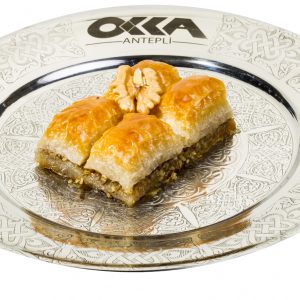Blog
The History of Baklava: A Sweet Journey Through Time

Baklava isn’t just a dessert—it’s a legend wrapped in layers of buttery pastry, sprinkled with history, and soaked in centuries of tradition. While it’s beloved around the world today, few people know the true origins of this sweet masterpiece.
Let’s take a journey through the fascinating history of baklava, from ancient empires to your plate in modern-day America.
🏛️ Ancient Roots and Early Influences
Baklava’s roots trace back thousands of years to ancient Mesopotamia, where early versions of layered breads with nuts and honey were prepared for royalty and the wealthy elite.
As civilizations evolved—Greeks, Persians, and Romans among them—so did the idea of sweet, layered pastries. But the version closest to modern baklava began to take form during the time of the Ottoman Empire, which ruled vast parts of the Middle East, Eastern Europe, and North Africa for centuries.
🕌 The Ottoman Empire: Birthplace of the Classic Baklava
It was in the royal kitchens of the Topkapi Palace in Istanbul that baklava found its signature shape and style. Skilled chefs refined the technique—rolling out ultra-thin phyllo dough by hand, layering it with crushed pistachios or walnuts, brushing each sheet with clarified butter, and finishing it with a sugar-based syrup.
During this era, baklava became a symbol of power, prestige, and hospitality. It was often served during celebrations, religious holidays, and as a gift from the Sultan to high-ranking officials.
📍 Why Gaziantep Is the Capital of Baklava
Although baklava was perfected in Ottoman palaces, the southern Turkish city of Gaziantep (Antep) is considered its spiritual home today. The region is famous for its Antep pistachios, which are smaller, greener, and more flavorful than other varieties.
Gaziantep’s baklava makers—often trained through generations—have elevated the craft into an art form. In 2013, “Antep Baklavası” received Protected Geographical Indication (PGI) status from the European Union, solidifying its authenticity and origin.
🌍 A Global Dessert with Many Faces
As the Ottoman Empire expanded, baklava spread across regions—each adding its own twist. You’ll find variations with:
- Walnuts in Greece
- Honey-based syrup in the Middle East
- Almonds in the Balkans
- Rosewater in Persian versions
While the ingredients and techniques may differ, the heart of baklava remains the same: a celebration of texture, sweetness, and skill.
🇺🇸 Baklava in America Today
In recent decades, baklava has become a favorite among dessert lovers in the U.S.—appearing in Middle Eastern restaurants, Turkish bakeries, and gourmet markets. But not all baklava is created equal.
That’s why at Okka Baklava LLC, we stay true to the roots. Master baker Zeynel Güçlü, with over 30 years of experience in Gaziantep, brings authentic Turkish baklava to American homes, made fresh in New Jersey with traditional ingredients and techniques.
🍽️ A Slice of History in Every Bite
Next time you enjoy a piece of baklava, remember—you’re not just tasting a sweet treat. You’re indulging in a recipe refined over centuries, crafted by generations, and loved across continents.
At Okka Baklava, we’re proud to keep this tradition alive—one flaky, pistachio-filled bite at a time.
